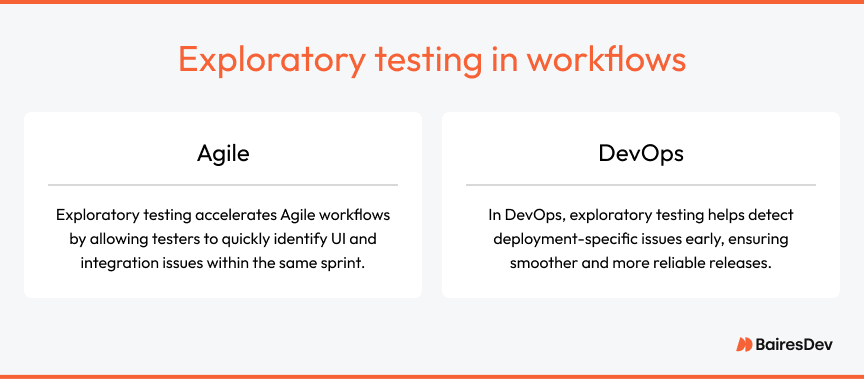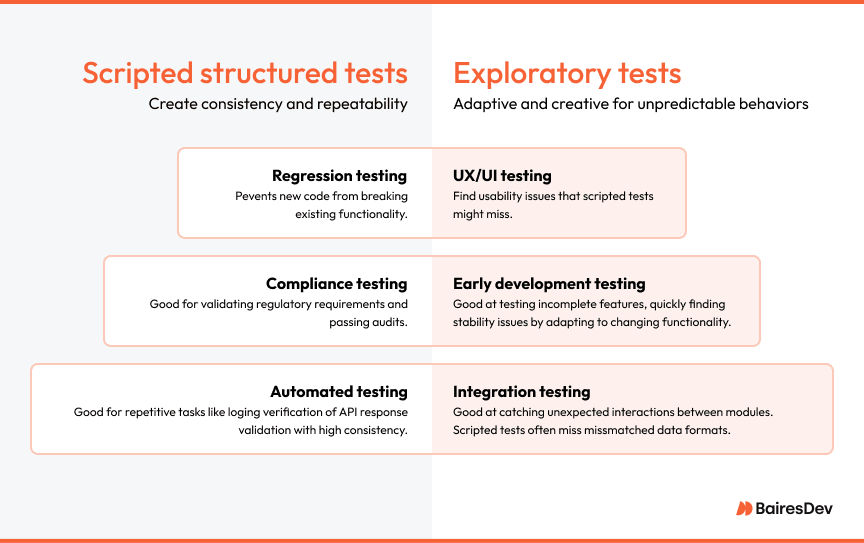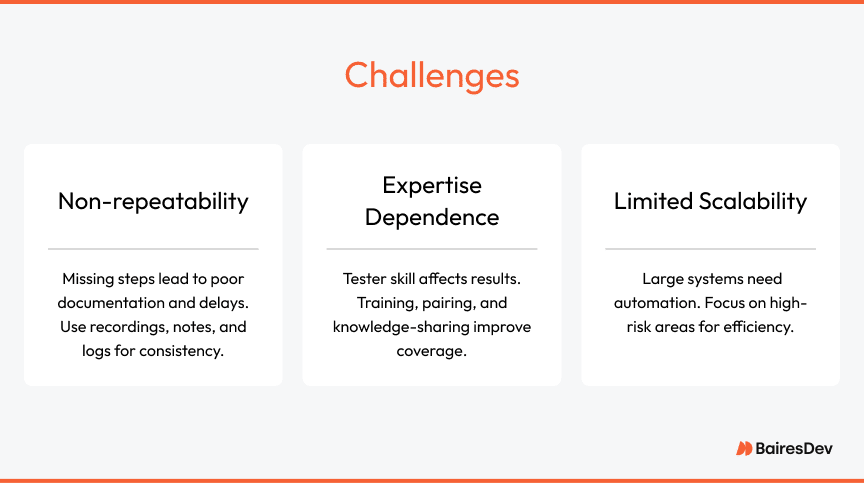Exploratory testing is a flexible, hands-on software testing technique that uses a tester’s skills and intuition. Unlike scripted testing, it finds defects as you go, preparing software for real-world use.
- Exploratory testing adapts to changing scenarios and finds hidden issues that a formal test script might miss.
- Scripted testing follows a set of predefined steps to get to a predictable, repeatable outcome.
Exploratory testing is a structured process that complements scripted tests to get broader test coverage. Experienced developers use scripted and exploratory testing to balance creative problem-solving with consistency and reliability.
What is exploratory testing?
Exploratory testing is a hands-on, unscripted testing technique that uses a tester’s creativity, experience, and intuition. By exploring the software, testers learn and adapt, finding usability issues and unexpected defects that formal testing processes or scripted tests might miss.
Exploratory testing loves flexibility and focuses on real-world scenarios and how users interact with the software. This makes it great for finding edge cases, usability and gaps in automated testing.
Purpose and goals
The purpose of exploratory testing is:
- Find hidden defects: Find bugs that only show up in real-world scenarios, especially from edge cases or unexpected user actions. For example, a financial app might crash when it tries to process multiple currencies in quick succession. Exploratory testing can find this, scripted tests might not.
- Improve usability: Find issues that frustrate users. With exploratory testing, testers put themselves in a user’s shoes to see if the software feels intuitive. This helps fix confusing workflows or awkward interface designs. A healthcare portal might confuse patients if the navigation labels are unclear.
- Complement scripted testing: Fill the gaps left by scripted or automated testing. Imagine an e-commerce site where scripts test the checkout flow but skip what happens if a user removes an item mid checkout.

Exploratory testing fits into Agile and DevOps workflows because it gives quick feedback. In a sprint, testers can find UI bugs or integration issues within hours of the feature being implemented. In DevOps exploratory testing helps catch deployment specific issues before release.
Despite its flexibility exploratory testing isn’t chaotic. It follows a defined testing process to guide the development team and improve software reliability.
Benefits of exploratory testing
Exploratory testing finds hidden defects, saves time and improves tester engagement, usability and reliability.
Flexibility
Exploratory testing gets out of the rigid test scripts and lets testers adapt to software changes on the fly. If a new feature behaves unexpectedly, testers can explore it without waiting for a scripted update. Testers use this real time adaptability to improve their coverage during dynamic testing. In a new API endpoint, a tester might find inconsistencies in the response formats that weren’t considered in the original test scripts.
Finding hidden issues
Exploratory testing finds bugs in edge cases that automated testing misses. A tester might find a bug that only shows up when they enter random emoji characters. Research shows exploratory testing can find more defects in cases like this than automated testing alone.
Tester engagement
Exploratory testing promotes creativity, keeps testers motivated and finds issues faster. Compared to running the same scripted tests over and over, exploratory testing is more engaging and rewarding. A tester might find a crash in a mobile app when they rotate the device mid action. She knows automated tests would never find that crash. This hands-on problem solving energizes her and keeps her invested. That high engagement leads to better software and more revenue.
Cost and time efficiency
Exploratory testing skips the upfront script writing, saving time. This is critical in Agile sprints or fast moving DevOps pipelines where speed is key. Testing can start immediately, testing effort goes where it’s needed most.
Exploratory testing principles
Exploratory testing is based on test scenarios, tester expertise and simultaneous learning and testing.
Simultaneous learning and testing
With exploratory testing testers learn about an application while they’re testing it. For example, a tester might discover inconsistent rounding rules in a financial app while learning how the currency conversion feature works.
Prioritizing user scenarios
Exploratory testing’s focus on real world user behavior checks the most important scenarios first. High priority user workflows are:
- E-commerce: Testing cart functionality under heavy load, for example during a flash sale or holiday season. This includes testing for issues like item duplication, slow checkout and payment gateway failures.
- Healthcare: Verifying patient data updates in real time, especially in multi user scenarios like doctors accessing shared records. This also includes testing data integrity and compliance to regulations like HIPAA.
- Finance: Verifying transaction accuracy during peak hours. Stock prices and account balances updating correctly when multiple transactions are processed in seconds.
- Education: Testing online exam systems for scalability and accuracy, for example, preventing answers from being lost during network interruptions or heavy user load.
Tester expertise
Experienced testers have creativity and domain knowledge that makes exploratory testing more effective. A healthcare specialist might find subtle data compliance issues, a finance tester might find vulnerabilities in tax calculations. Experienced testers are good at using manual testing techniques to adapt quickly and find hidden risks.
Exploratory testing vs scripted testing
Scripted and exploratory testing both have their place in improving software quality.
Approach differences
Exploratory testing is adaptive, scripted testing is more rigid.
Scripted tests follow a predefined sequence to create consistency and repeatability. They’re good for verifying requirements and finding predictable issues. They fit into precision workflows like payment processing or regulatory compliance checks.
Exploratory testing is adaptive and creative. Unlike formal tests, testers interact with the software to find hidden issues. Exploratory testing is good for user behavior or system responses that are unpredictable. It’s a great complement to structured testing for edge cases and usability issues.

Scripted, structured tests are good for:
- Regression testing: Scripted testing prevents new code from breaking existing functionality. By following a sequence of steps it reliably detects regressions in established workflows and systems.
- Compliance testing: Scripted testing is good for validating regulatory requirements. Predefined test cases ensures thorough coverage. This is required for passing audits and meeting regulatory standards.
- Automated testing: Scripted formal testing is good for repetitive tasks like login verification or API response validation. Automation scales these tests with high consistency across large amount of data and scenarios.
Exploratory testing is good for:
- UI/UX testing: Exploratory testing is best here because it finds usability issues that scripted tests might miss. Testers can navigate through the application, find confusing layouts and provide real time feedback.
- Early development testing: Exploratory testing is good at testing incomplete features. Testers can adapt to changing functionality, quickly finding stability issues in rapidly changing environments.
- Integration testing: Exploratory testing is good at catching unexpected interactions between modules. For example scripted tests often miss mismatched data formats or misaligned system behavior.
Pros and cons
Scripted and exploratory testing both have their strengths and weaknesses. They work together best.
Exploratory testing adapts to changes, finds unexpected issues and improves usability through creative problem solving. But exploratory testing relies on human expertise and is harder to repeat.
Scripted testing provides repeatability, thoroughness and consistency so it’s good for regression and compliance testing. But it’s limited to predefined scenarios and can miss edge cases and user behavior outside the script.
To have high quality software with full coverage, combine both scripted and exploratory testing. Use scripted tests for automation and for creating predictable workflows. Use exploratory testing for edge cases and usability improvements.
Techniques and tools for exploratory testing
Exploratory testing uses structured sessions, targeted heuristics and tools like TestRail or Jira.
Session based test management
Session based exploratory testing adds structure through defined time blocks called sessions. Each session outlines goals with a specific test charter like testing a login system under multiple conditions. This keeps focus and flexibility for more coverage and efficient use of resources and QA testing services.
Heuristic-based testing
Heuristics guide exploratory testing by identifying potential problem areas. Common testing techniques are:
- Boundary value analysis: Tests edge cases like entering the maximum or minimum value in a numeric field. It may enter invalid inputs like negative numbers or leave optional fields empty.
- Error guessing: Tests problems like submitting a form without required fields, entering special characters in a username field or inputting a future date for past dated records.
- State transition testing: Verifies system behavior when moving between states like logging in and logging out multiple times.
- Equivalence partitioning: Divides inputs into groups that should produce the same result and tests one value from each group.
Tools for exploratory testing
Tools like TestRail, PractiTest and Jira can help with documentation and reporting in exploratory testing. For example:
- TestRail: Organizes sessions, tracks test data and generates reports to verify repeatability and testing accuracy.
- PractiTest: Integrates test management with issue tracking, smooth workflows and real time updates for defect resolution.
- Jira: Documents exploratory testing activities, tracks progress and provides team collaboration through shared dashboards and customizable workflows.
Best practices for exploratory testing
Exploratory testing is all about following best practices. Developers should set clear objectives, collaborate with the testing team and document all findings.
Set clear objectives
Set specific goals for each exploratory testing session. For example use testing tools in one session and test scenarios in another. Set goals that fit with project requirements like testing critical user paths like login or payment processing.
| Sample Objective | Purpose |
| Test login functionality | All user roles can access the system securely without errors. |
| Test payment processing | Transactions complete correctly, including edge cases like invalid payment details. |
| Test new feature stability | Crashes or unexpected behavior during early development phases. |
| Test API response | APIs return consistent and valid data for all inputs. |
Work with development teams
Collaboration helps with communication and defect resolution. Work closely with developers to get deeper into the software. Discuss new APIs to find potential problem areas and edge cases. Review logs and performance metrics together to find hidden bottlenecks. Create a testing approach that fits project requirements and security goals.
Looking to hire QA testers? Our developers are fully-vetted and selected from the top 1% of LATAM developers.
Document findings
Document your findings in a way that allows you to reproduce and fix all defects. Include:
- Steps to reproduce: Clearly describe the sequence of actions that caused the defect. Include navigation paths, button clicks or system events.
- Test data: List all the inputs that caused the issue, like field values or parameters. Include variations tested to narrow down the scope.
- Screenshots/logs: Attach screenshots of errors, system logs or timestamps. Highlight specific error messages or behaviors so developers can reproduce and diagnose the defect.
For example, while testing software for an e-commerce platform, document a crash caused by an invalid promo code. Include the promo code used, browser version, navigation steps and screenshot of the error message. This will help developers to reproduce and fix the defect.
Exploratory testing challenges and how to overcome them
Exploratory testing has several challenges like non-repeatability, expertise dependence and limited scalability. By addressing these issues, exploratory testing becomes more efficient and reliable. By refining their approach teams can create functional testing solutions for different project scope and get better results.
Non-repeatability

QA is important because it saves money and customer satisfaction. But without test cases, testers might forget steps or miss important details. That can lead to incomplete documentation and delayed fixes.
Strategies to improve repeatability:
- Use session recordings to capture actions and results: Record your exploratory testing so you don’t miss steps or behaviors.
- Write step-by-step notes during testing: Include navigation paths, specific inputs, observed results and update test cases for clarity.
- Document test data and environment variables: Note all variables like browser settings or API endpoints used.
- Attach logs or screenshots to defects: Provide evidence of errors in all test cases for faster debugging and resolution.
Expertise dependence
Exploratory testing depends on the tester’s skills, creativity and expertise. Inexperienced testers might miss critical issues or not cover high risk areas.
Solutions to overcome expertise dependence:
- Run training programs on testing techniques like boundary value analysis.
- Pair experienced testers with new ones in testing sessions.
- Share knowledge across the testing team through test charters and post-session reviews.
Limited scalability
Exploratory testing can be challenging for large projects due to time and resource constraints and can’t provide coverage across complex systems on its own.
Recommendations to scale:
- Combine exploratory testing with automation for repeatable workflows.
- Use TestRail or Jira to manage exploratory testing sessions.
- Focus exploratory testing on high risk test cases. Use automated testing for repetitive tasks.
By addressing these challenges exploratory testing becomes a more valuable tool for improving software quality.
When to use exploratory testing
Exploratory testing works best in situations where adaptability and creativity is required. Use it during early development stages, user experience testing and fast paced environments like Agile and DevOps. Exploratory testing can complement other structured testing methods to get better overall test coverage.
During early development stages
Exploratory testing excels when features are incomplete or changing rapidly. It identifies test cases that need further refinement and detects deep issues early in the process. For example, a tester can test login functionality in its infancy to find inconsistent error handling and refine test cases. This saves development time by fixing issues before automation is introduced.
| Scenario | Purpose |
| Login functionality testing | Find errors like inconsistent password rules or vague error messages during early development. |
| API integration validation | Find issues with data formats or unexpected responses while APIs are still evolving and document these in test cases. |
| Navigation flow exploration | Find broken links or incomplete workflows in initial prototypes of user interfaces. |
For user experience and usability testing
Use exploratory testing to validate design and test real-world workflows. During e-commerce testing, they might find usability issues like unclear cart navigation or slow page responses.
| Scenario | Purpose |
| E-commerce cart navigation | Find unclear paths or confusing design elements in cart workflows. |
| Page load time assessment | Find slow responses that will frustrate users and cause drop-offs. |
| Mobile app usability checks | Find issues like unintuitive gestures or hidden critical features. |
In Agile and DevOps environments
Exploratory testing fits into fast-paced development by providing quick feedback. For example, a tester can validate a new API to make sure it doesn’t break other systems. However, exploratory testing doesn’t scale well. That’s why exploratory testing is often combined with automation.
| Scenario | Purpose |
| Real-time API validation | Validate APIs deliver consistent and accurate data under changing conditions. |
| Continuous integration builds | Find integration issues early to keep the pipeline stable. |
| Sprint-end feature testing | Verify new features work as expected before delivery or release. |
Summary
Exploratory testing is a quick way to find hidden defects and improve software quality. Its adaptability and creative problem solving fits edge cases and real world scenarios that traditional testing misses.
Agile teams can combine exploratory and structured testing to get better reliability, usability and performance of their software. This hybrid approach gives comprehensive coverage and balances creativity with repeatability.
FAQs
What is exploratory testing good for?
Exploratory testing is good for situations where adaptability and creativity is required. It’s useful for:
- Usability testing: Find confusing navigation or interface issues.
- Finding hidden defects: Find defects missed in structured testing.
- Validating incomplete features: Test during early development.
- Identifying test cases: Find test cases for edge cases.
These exploratory testing techniques give full test coverage and edge cases.
How is exploratory testing different from ad-hoc testing?
Exploratory testing is structured with defined goals and documentation, ad-hoc testing has no direction. By focusing on specific objectives and tracking test cases exploratory testing gives more reliable results and actionable feedback.
Exploratory testing is more systematic, using session charters and test notes to guide and document progress. Ad-hoc testing is informal and unplanned and can miss issues or not cover everything. Exploratory testing combines creativity with structure, makes it a more effective and scalable testing approach.
Can exploratory testing replace automation?
No, exploratory testing complements automation but can’t replace it. Automation is good for repetitive tasks and predictable scenarios. Exploratory testing is good for creative and adaptive testing. Together automated and exploratory testing gives comprehensive coverage for software quality.
Automation can handle large scale, repeatable tasks fast and precise like regression testing across multiple builds. Exploratory testing finds unique issues by mimicking real user behavior. When combined, they improve software quality by covering both predictable scenarios and edge cases.
Do exploratory testers need technical skills?
Technical skills help freestyle exploratory testing but are not always required. Problem solving skills and domain knowledge can be just as valuable. Non-technical testers can contribute by testing real workflows and user-centric software testing techniques.
While technical skills enhance exploratory testing by allowing deeper debugging and system-level analysis, strong problem solving and observational skills are equally important. Non technical testers bring a user-focused perspective, find usability issues and workflow bottlenecks that may be missed by technical approaches.
How is exploratory testing documented?
Documentation in exploratory testing captures session details so defects can be reproduced and fixed. Use TestRail and Jira to organize test cases, link defects to findings and keep a testing history for the testing team.
Include:
- Notes: Observations, anomalies, test cases and defects found during the session.
- Screenshots/logs: Visual evidence to support findings and debugging.
- Test cases: Step-by-step instructions for developers on how to reproduce issues.






